Good Vibrations: Transforming Cooling and 3D Printing in Space
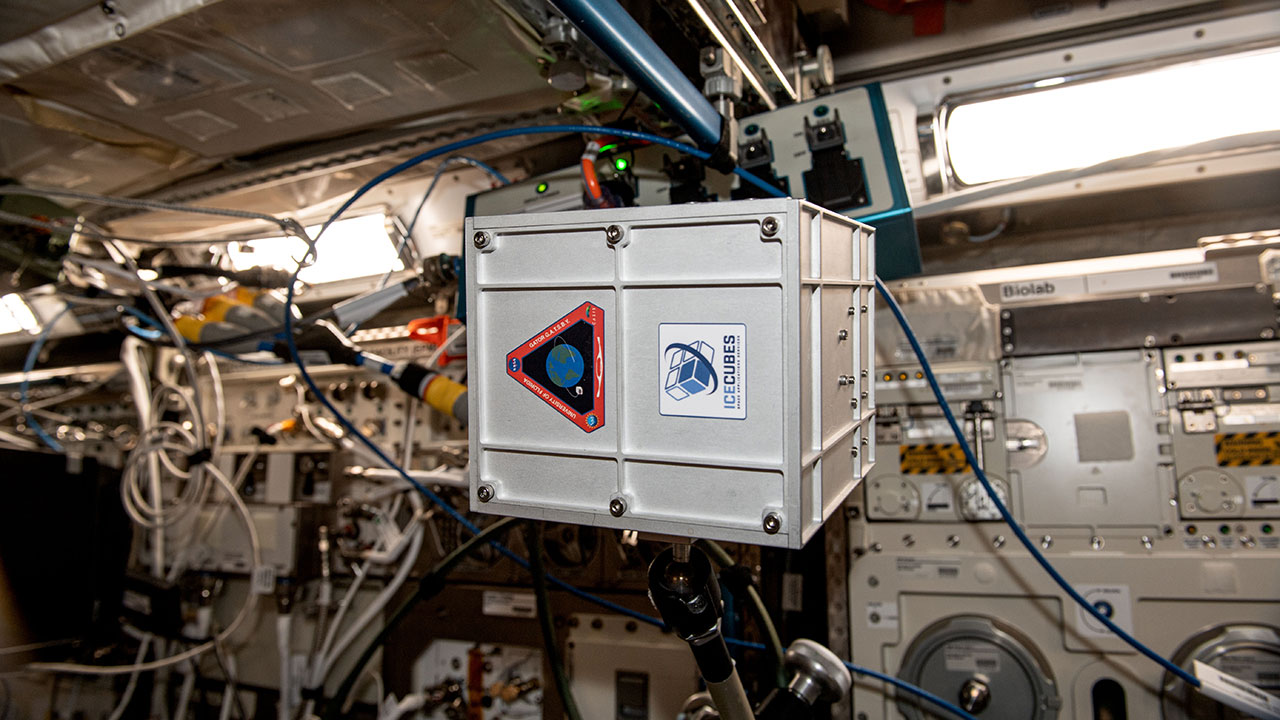
November 19, 2025 • By Amelia Williamson Smith, Managing Editor
It was a dark and cloudy April morning in 1850 near Angers, France. Three battalions of French soldiers approached the Basse-Chaîne Bridge, which provided passage over the Maine River. Just as the third battalion stepped on the bridge, a fierce storm broke out.
As the nearly 500 soldiers marched across, the large suspension bridge began to sway in the gusting wind. Despite the driving rain, the soldiers continued to march in unison, their boots coming down in a rhythmic thud. When they reached the middle of the bridge, suddenly, there was a loud snap. The bridge gave way, and the soldiers were thrown into the raging river beneath. More than 220 people died in the tragic event.
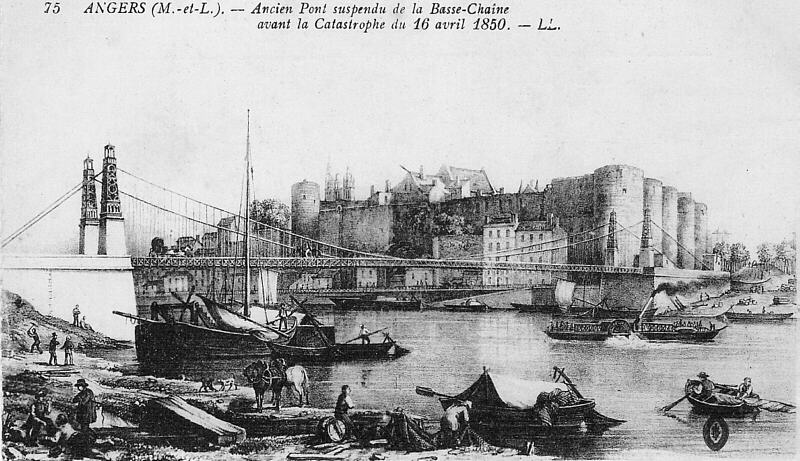
The Basse-Chaîne Bridge prior to its collapse in April of 1850.
Media Credit: Wikimedia Commons
The culprit for this disaster was resonance. When a system is vibrated at a frequency matching its natural frequency, it creates resonance, which amplifies the system’s oscillations. To understand natural frequency, picture what happens if you bump a plate of Jell-O. The Jell-O jiggles, or oscillates, back and forth before eventually coming to rest. The frequency of those oscillations is the natural frequency. In the case of the soldiers, the vibration from their marching matched the natural frequency of the suspension bridge, amplifying the oscillations until the bridge violently broke apart.
The power of resonance can be destructive, but a team of scientists at the University of Florida (UF) aims to harness it for something good. They want to use resonance to address an important challenge in space: heat removal.
“We will need thermal management when we inhabit the Moon and Mars,” said UF distinguished professor Ranga Narayanan. “We’ll have energy sources like nuclear reactors, and we’re going to have to remove the heat from the system quickly.”
On Earth, passive liquid cooling transfers heat out of systems using natural convective currents. But in space, there’s a complication.
“If there’s no gravity, you don’t have fluid naturally flowing from high density to low density, forming convective cycles, which is a key heat transfer mechanism on the ground,” explained Thomas Corbin, a Ph.D. student in Narayanan’s lab. “Resonance is a way we can circumvent this issue by inducing flow.”
When a liquid is vibrated at the precise frequency to create resonance, a pattern of waves forms, causing the liquid to flow. However, to design heat removal technology based on resonance, researchers must fully understand the dynamics of how and why the fluid moves. Surface tension is a key part of that, but it’s hard to study on Earth because gravity is too strong and overpowers it.
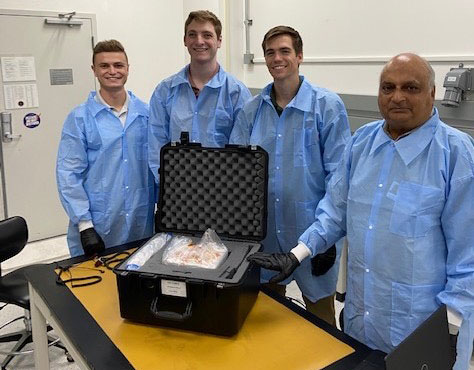
The University of Florida team at Kennedy Space Center preparing its ISSInternational Space Station National Lab-sponsored and NSF-funded investigation for launch. (left to right: Craig Singiser, Zach Karpinski, Jason Livesay, Ranga Narayanan)
Media Credit: Aerospace Applications North America
The research team needed a way to remove gravity, and the International Space Station (ISS) National Laboratory provided the perfect platform.
“There are a number of things that can be learned when you exclude the effects of gravity,” Corbin said. “You have a force that plays a massive role on Earth that is suddenly very diminished, so you can get new science because you’re in a completely different environment.”
Faraday and His Violin
In the early 1830s, English physicist and chemist Michael Faraday was intrigued by how vibrations affect materials. Building on the work of earlier scientists like Ernst Chladni, Faraday conducted experiments using a sand-covered metal plate and a violin bow. When he slid the bow along the edge of the metal plate, the sand formed into geometric patterns, a striking visualization of resonance.
Faraday pushed his vibration studies further and designed an experiment to vertically shake a shallow container of liquid. When the amplitude and frequency of the shaking were low, the liquid’s surface remained flat. As the frequency increased, the system reached a critical threshold where the surface became unstable and formed a pattern of standing waves. This phenomenon is known as Faraday instability.
Now, nearly two centuries later, the UF research team is building on Faraday’s curiosity—in space. As part of a project funded by the U.S. National Science Foundation (NSF) and sponsored by the ISS National Lab, the team designed a system to vertically shake fluids to see how they behave in microgravityThe condition of perceived weightlessness created when an object is in free fall, for example when an object is in orbital motion. Microgravity alters many observable phenomena within the physical and life sciences, allowing scientists to study things in ways not possible on Earth. The International Space Station provides access to a persistent microgravity environment.. The system had to be compact: less than seven pounds and able to fit in a box smaller than a toaster.

Michael Faraday on engraving from the 1850s. English chemist and physicist who contributed to the fields of electromagnetism and electrochemistry. Engraved by J. Cochran and printed in London
Media Credit: By H. W. Pickersgill, Esq. R. A.
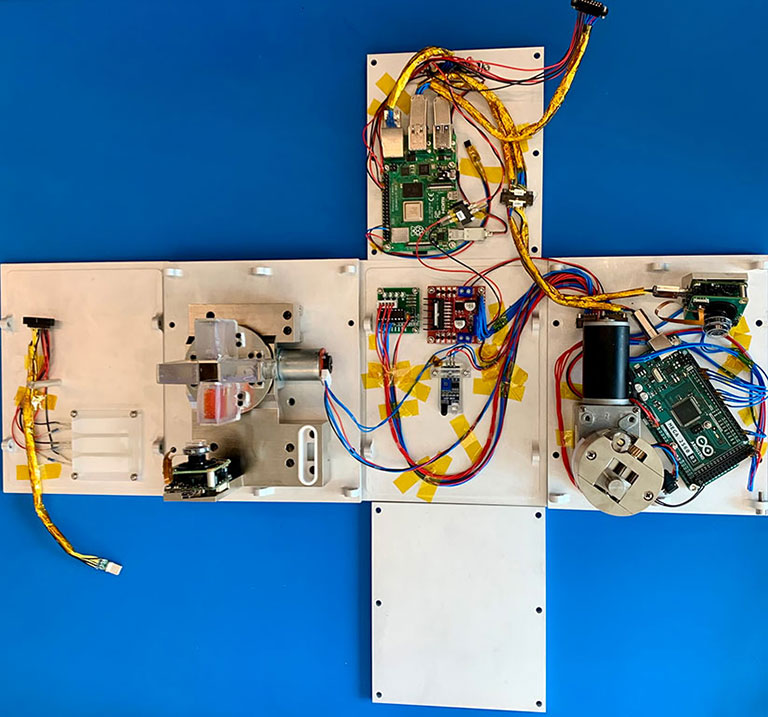
Unfolded ICECUBES hardware with the shaking system and four fluid-containing cells.
Media Credit: University of Florida
Narayanan and his team—which included Corbin, Ph.D. student Jason Livesay, and undergraduates Craig Singiser and Zach Karpinski—3D printed the components for the system and had them machined. The team then began working with ISS National Lab Implementation Partner(Abbreviation: IP) Commercial companies that work with the ISS National Lab to provide services related to payload development, including the translation of ground-based science to a space-based platform. Aerospace Applications North America (AANA). They integrated the parts into one of the company’s International Commercial Experiment Cubes (ICE Cubes) that hosts experiments on the ISS.
Inside the ICE Cubes hardware were four small containers. Each held two fluids that do not mix, like oil and water. The researchers wanted to see what happened at the line where the liquids meet, called the interface, when they vibrated the containers.
The team had created theoretical models of the fluid flow, but Narayanan wondered, “Will we see the interface begin to deflect in space the way we expect it to?”
Viewing Vibrations in Space
The investigation launched on Northrop Grumman’s 18th commercial resupply services mission(Abbreviation: CRS mission) A CRS mission is a cargo resupply mission contracted by NASA to deliver supplies and research to the International Space Station on commercial spacecraft as part of the CRS contract with three commercial companies. As part of CRS missions, experiments currently return to Earth on SpaceX Dragon spacecraft that splash down in the ocean.. Controlling the system from the ground, the team performed 800 experimental runs over six months. Their goal was to see whether vibrating liquids in microgravity could unlock new ways to move heat, a crucial step toward keeping future space habitats safe and livable.
The team shook the containers at a set frequency. They started with a low amplitude and slowly built up to find the critical threshold where wave patterns would form. High-resolution video cameras captured the movement of the liquids.
“If we didn’t have the wave patterns yet, we would increase the amplitude, and we’d continue to do this iteratively until we saw dramatic waveforms,” Livesay said. “We’d do it for each of the test cells and then go back through and compare what we saw to our theoretical predictions.”
It was a little complicated, though, because in space, the two fluids didn’t stay in place with one interface between them like the team thought. Instead, one liquid encapsulated the other.
“That’s part of the fun of working in space,” Livesay said. “Sometimes it’s a little unpredictable.”
Despite the complication, the team was able to isolate the effects of surface tension, gleaning valuable insights. They also made an unexpected and exciting discovery. On the ground, when liquids are vibrated vigorously enough, the interface breaks, and one fluid disperses into the other. But in space, that did not happen.
“When we saw that the interface didn’t break in space, it had a big implication,” Narayanan said. “If it’s not going to break, it means we could use Faraday waves in space for a number of things.”
A container holding two fluids is shaken vertically on the ISS to study the Faraday wave patterns that form at the interface between the fluids.
Credit: University of Florida
The next step is to test how well the fluid flow moves heat in microgravity, which the team will do in an upcoming investigation sponsored by the ISS National Lab.
“We have a lot of flow, and flow does something interesting—it’s able to carry heat,” Narayanan said. “Our hypothesis is that it’s going to improve heat transfer enormously, which will ultimately be helpful for thermal management in space.”
Applying Resonance to Additive Manufacturing
Building on their successful research, Narayanan and his team had another idea. They began work on a new ISS investigation, this time harnessing resonance to improve 3D printing with metals, particularly in remote locations like space.
“If you’re going to make something in space, you better make it right the first time,” Narayanan said. “It takes a lot of energy to make things, and power comes at a premium.”
Additive manufacturing has valuable applications in remote locations on Earth, too. For example, someone could create a surgical implant for a wounded soldier while on the battlefield or make a specific tool on a submarine when there is no time to resurface.
“Many of these environments will have manufacturing facilities, where they’re not just 3D printing plastic but 3D printing metals,” Narayanan said. “You can’t make mistakes because time is of the essence.”
One method of 3D printing with metal uses a wire that comes out of a feeder. A heat source melts the wire to form a puddle of metal on a platform. As the platform moves back and forth, the liquid metal smears, forming a layer that solidifies as it cools. Layer by layer, a new tool or part is created.
However, there’s a catch: ripples can form in the liquid metal. The platform must move at a specific speed, or it won’t create a proper layer, Corbin explained.
“It will either be beaded up or wavy, and those imperfections will then be propagated throughout your system, so you’ll have misprinted tools or just completely failed prints,” he said. “You need to know surface tension and viscosity and other properties so you can get the correct speed and print your parts correctly.”
These properties can be determined using resonance, but it isn’t easy to do on Earth. Once again, the problem is the overpowering force of gravity.
Melting Metals in Microgravity
With a special furnace at NASA’s Marshall Spaceflight Center, Narayanan and his team can use electrostatic force to levitate a liquid metal sphere. By applying an alternating current, they can move the sphere up and down, causing it to vibrate. When the sphere reaches a critical frequency, it begins to change shape in an oscillating pattern. Using a formula and this critical frequency, the team can calculate the
But metals are dense, and it takes a significant electrical force to keep even tiny metal spheres levitated. Also, gravity is pulling down, which can cause the spheres to sag and form more of a pear shape. To solve these challenges, the team again turned to space.
“In microgravity, because the metal sphere is already kind of free-floating, you barely have to hold it in place,” Livesay said. “So, it makes it much easier to do.”

The ground-based levitator the team used to conduct molten metal experiments.
Media Credit: NASANational Aeronautics and Space Administration MSFC
A molten metal alloy is shaken in microgravity to observe the Faraday wave patterns.
Media Credit: University of Florida and JAXA
In a NASA-funded project, the team collaborated with the Japanese Space Agency to use its electrostatic levitation furnace in the Kibo module of the ISS. They levitated and vibrated six liquid metals, using high-speed video cameras to capture the motion of the two-millimeter-sized spheres.
The results were excellent, Narayanan said. The team developed a new method to measure the surface tension of liquid metals in space and could use a similar technique to determine viscosity. Based on these findings, the team filed two patents and submitted a paper to the journal npj Microgravity. They hope to use their new method to build a database of liquid metal properties for use in additive manufacturing.
“We’re looking at how we can provide accurate values of the surface tension and other properties so companies 3D printing with metals are not just predicting how the metal will behave, but they can actually know how it will behave,” Livesay said.
The Fundamentals of Fluid Flow
Whether you’re vibrating a container of liquid or a levitated metal sphere, Faraday instability gives rise to patterns, and these patterns can be put to good use, Narayanan said. It all comes down to understanding the fundamental science.
“We can now say we understand the science of this fluid motion,” he said. “We know we can use the flow to enhance heat transfer for thermal management in space and want to come up with a device based on this. We also know we can use it to find the correct viscosity and surface tension of metals for 3D printing, so we don’t have to print things again and again.”
Findings from the team’s ISS research will inform the development of critical technology for future missions on the Moon, Mars, and beyond. Every technological device we take for granted today has come from fundamental science, Narayanan explained.
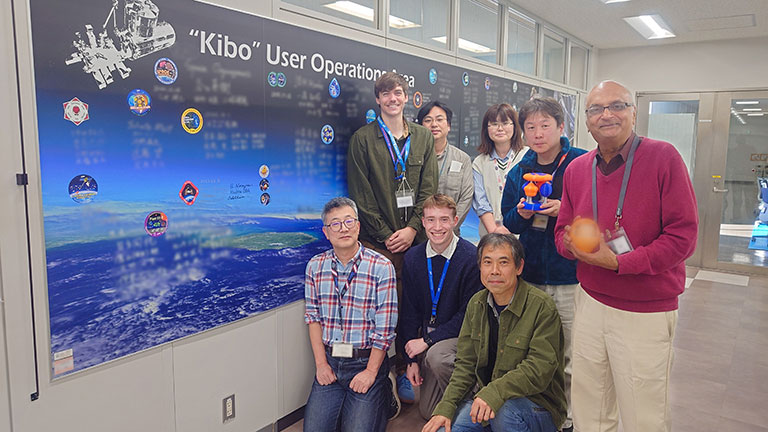
University of Florida team members Jason Livesay (back, far left), Ranga Narayanan (back, far right) and Thomas Corbin (front, center) with JAXA colleagues after completing their NASA-sponsored molten metals investigation.
Media Credit: JAXA
“If you think the next generation of technology will come from the current one, it won’t—advances will only be incremental,” he said. “If you want to make the next leap, you need the fundamental science, and that’s what we’re hoping to show.”